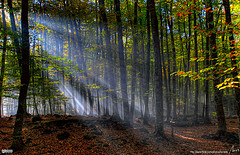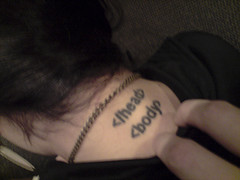January 30th, 2009 by Kevin Lindstrom | No Comments »
Antique Plutonium
Manhattan Project-era plutonium is found in a glass jug during Hanford Site cleanup.
One of the oldest known samples of plutonium has been dug up from a waste trench in Hanford, Wash., near the now-decommissioned nuclear production site along the Columbia River. During the process of figuring out the plutonium’s origin and history, a new technique emerged that may help nuclear scientists identify the age and source of trafficked nuclear material.
For the full article, go to Latest News section of Chemical and Engineering News.
Submitted by Kevin Lindstrom Liaison Librarian for Chemistry and Physics
Posted in Chemical and Biological Engineering, Chemistry, Earth and Ocean Sciences, General Science, Physics, Science - undegraduate classes | No Comments »
January 27th, 2009 by Eugene Barsky | No Comments »
This well-edited little video does a good job of tracing the rise of the internet from early networking efforts to birth of the TCP/IP protocol.
History of the Internet from PICOL on Vimeo.
UBC Library has a number of books on this topic as well. Try searching for Internet AND history in our library catalogue.
Posted in Main, Science - undegraduate classes | No Comments »
January 23rd, 2009 by Kevin Lindstrom | No Comments »
Here’s a recent article by UBC Physics and Astronomy researchers Zibin, Moss, and Scott
Can we avoid dark energy? Zibin, James P. Moss, Adam; Scott, Douglas.Physical Review Letters, 101(25) p. 251303 2008.
Abstract: The idea that we live near the center of a large, nonlinear void has attracted attention recently as an alternative to dark energy or modified gravity. We show that an appropriate void profile can fit both the latest cosmic microwave background and supernova data. However, this requires either a fine-tuned primordial spectrum or a Hubble rate so low as to rule these models out. We also show that measurements of the radial baryon acoustic scale can provide very strong constraints. Our results present a serious challenge to void models of acceleration.
Need more background information on Einstein-de Sitter spacetime? Or the Friedmann-Lemaitre model?
Have a look at the Encyclopedia of Astronomy and Astrophysics
A search of Springer’s ebook collection for Einstein-de Sitter gives the following results.
For additional ebooks on the topic, have a quick browse of Springer’s Physics and Astronomy collection.
Need a comprehensive list of databases, ejournals and related resources? Check out the Science and Engineering subject guides for Astronomy and Physics.
Submitted by Kevin Lindstrom Liaison Librarian for Physics and Astronomy
Posted in General Science, Mathematics, Physics, Science - undegraduate classes | No Comments »
January 20th, 2009 by Eugene Barsky | No Comments »

From the Food and Agriculture Organization of United Nations (FAO) website:
http://www.fao.org/forestry/52980/en/
This 17-minute video presentation, produced by FAO and the Forestry Commission of the United Kingdom, shows how much forests can contribute to the mitigation of climate change, stressing the importance of reversing forest loss.
Forests store more carbon than all the world’s remaining oil stocks. Continuing deforestation and forest degradation account for almost one-fifth of the world’s greenhouse gas emissions – more than the entire global transport sector. The presentation explains how society can combat climate change by conserving and managing existing forests, by tackling causes of deforestation and by planting new forests. It stresses the use of wood as a renewable energy source and as a raw material, pointing out that wood products store carbon for their entire lifetime, until they decay or are burned. A section on adaptation notes how the world’s changing climate will affect the health and composition of forests and stresses the importance of adapting and planning ahead for the changes.
** Photo by MorBCN
Posted in Earth and Ocean Sciences, Main, Science - undegraduate classes, Wood Sciences | No Comments »
January 15th, 2009 by Eugene Barsky | No Comments »

The US National Security Agency has helped put together a list of the world’s most dangerous coding mistakes.
Experts from more than 30 US and international cyber security organizations jointly released the consensus list of the 25 most dangerous programming errors that lead to security bugs and that enable cyber espionage and cyber crime. Shockingly, most of these errors are not well understood by programmers; their avoidance is not widely taught by computer science programs; and their presence is frequently not tested by organizations developing software for sale.
BBC news article lists the mistakes here – http://news.bbc.co.uk/2/hi/technology/7824939.stm
** Photo by Marco Gomes
Posted in Amusing stuff, Main, Mathematics, News, Science - undegraduate classes | No Comments »
January 9th, 2009 by Kevin Lindstrom | No Comments »
Professor David McClung from the Department of Geography has published more than forty articles dealing with slab avalanches, avalanche risk, and avalanche forecasting.
Dr. McClung’s most recent publications include
Expanding the snow-climate classification with avalanche-relevant information: initial description of avalanche winter regimes for southwestern Canada. Haegeli, Pascal; McClung, David M. Journal of Glaciology, Volume 53, Number 181, March 2007, pp. 266-276.
Dry snow slab shear fracture speeds McClung, D.M. Geophysical Research Letters, Volume 34, 2007, L10502.
Snow Avalanches as a Non-critical, Punctuated Equilibrium System in Nonlinear Dynamics in Geosciences, Springer Verlag, 2007.
Thinking about heading into the back country? It might be useful to consult the Avalanche Handbook coauthored by David McClung and Peter Schaerer.
Other relevant avalanche websites include:
BC Provincial Emergency Program Avalanche Information
Canadian Avalanche Centre
Canadian Avalanche Foundation
Submitted by Kevin Lindstrom Liaison Librarian for Earth and Ocean Sciences, Physical Geography
Posted in Atmospheric Science, Civil Engineering, Earth and Ocean Sciences, Geography, Main | No Comments »
January 5th, 2009 by Eugene Barsky | No Comments »
The 2008 edition of this ever popular video is out for the masses.
I enjoyed to view it for the first time a couple of years ago and I have to admit that the video did not change much.
However, it might still surprise and entertain you:
Posted in Amusing stuff, Main | No Comments »


